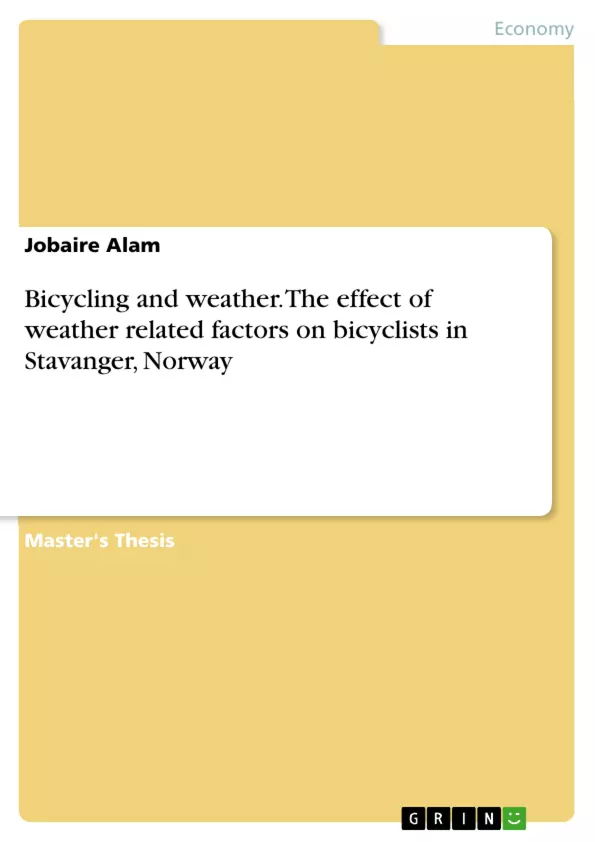Bicyclists and bicycle commuters in many parts of the world face various challenges congenital simultaneously non-motorized transportation and car-centric roadways. Bicycle commuters in west coastal city Stavanger of Norway confront the obstructions of the north Scandinavian climate in addition, which makes bicycling exceedingly a seasonal activity. On the other hand, bicyclists in Stavanger keep on facing limitations of transportations, particularly when defeating northern weather conditions. The purpose of this study was to focus on the leading concerns for bicyclists in Stavanger with the aim of identifying and perceiving distinctive challenges by various weather conditions, which can be defeated by policy, behavioral and infrastructural improvement.
The researcher examined the issues surrounded around bicyclists in Stavanger through in-depth contented exploration of transcripts from focus groups and individual interviews. Therefore, precipitation, wind, cold temperatures, inclement road conditions, limited daylight hours and wind were determined as unregulated obstructions for bicyclists all around the year. These obstructions have set the parabolic resistance on many potential bicycling trips. The dealing of such issues was identified to be identical to individual bicyclists that stood on perceptions of cyclists on subtle variations in weather conditions on individual easement and safety.
Inhaltsverzeichnis (Table of Contents)
- Abstract
- Copyright and Ownership of Intellectual Property Rights
- Acknowledgements
- Chapter 1: Introduction
- 1.1: Background of the study
- 1.2: Problem statement
- 1.3: Research questions
- 1.4: Objectives of the study
- 1.5: Delimitations
- 1.6: Significance of the study
- 1.7: Structure of the thesis
- Chapter 2: Literature Review
- 2.1: Literature on weather
- 2.2: Literature on bicycle commuters
- 2.3: Literature on weather related factors affecting bicycle commuters
- 2.4: Literature on the relationship between weather related factors and bicycle commuting
- 2.5: Literature on policy, behavioral and infrastructural improvements
- 2.6: Gap in the literature
- Chapter 3: Research Methodology
- 3.1: Introduction
- 3.2: Research approach
- 3.3: Research design
- 3.4: Population and sample
- 3.5: Data collection methods
- 3.6: Data analysis methods
- 3.7: Ethical considerations
- Chapter 4: Findings and Analysis
- 4.1: Introduction
- 4.2: Precipitation
- 4.3: Wind
- 4.4: Cold temperatures
- 4.5: Inclement road conditions
- 4.6: Limited daylight hours
- 4.7: Discussion of findings
- Chapter 5: Conclusion and Recommendations
Zielsetzung und Themenschwerpunkte (Objectives and Key Themes)
This thesis aims to explore the impact of weather-related factors on bicycle commuters in Stavanger, Norway, identifying the key challenges they face and exploring potential solutions.
- The influence of various weather conditions on bicycle commuting behavior.
- The specific challenges faced by bicycle commuters in a Nordic climate.
- The potential for policy, behavioral, and infrastructural improvements to mitigate these challenges.
- The role of perception and individual choices in navigating weather-related obstacles.
- The need for further research to better understand the interplay between weather, infrastructure, and cycling behavior.
Zusammenfassung der Kapitel (Chapter Summaries)
This thesis begins by providing a comprehensive overview of the research topic, including the background, problem statement, research questions, objectives, delimitations, significance, and structure of the study. The literature review explores existing research on weather, bicycle commuters, and the relationship between these two factors. It also discusses the impact of policy, behavioral, and infrastructural improvements on bicycle commuting. This chapter further identifies a gap in the literature that the current study aims to address. The research methodology chapter details the approach, design, population, sample, data collection methods, data analysis techniques, and ethical considerations employed in the study. This is followed by a chapter dedicated to presenting and analyzing the findings of the research.
Schlüsselwörter (Keywords)
The study primarily focuses on the impact of weather-related factors on bicycle commuters in Stavanger, Norway. Key terms include bicycle commuting, weather conditions, climate, precipitation, wind, temperature, road conditions, daylight hours, policy, behavior, infrastructure, perception, and safety. The study aims to contribute to a better understanding of the challenges and opportunities associated with promoting bicycle commuting in a Nordic climate.
- Quote paper
- Jobaire Alam (Author), 2015, Bicycling and weather. The effect of weather related factors on bicyclists in Stavanger, Norway, Munich, GRIN Verlag, https://www.grin.com/document/312889



